The College Football Dilemma
College football is at a crossroads. The signs are everywhere. Attendance is down. Viewership is down. Most bowl games are as unremarkable as their sponsors are unremembered. While the Millennials are cutting the cord and the oldest generation is cutting back on travel, the youngest generation is watching Fortnite on Twitch.
How will all these systemic problems be fixed? Double the size of the playoff, of course! It will fix everything!
Bill Hancock has recently said that an 8-team playoff is, “not in the cards”. It sounds awfully like the rhetoric from the BCS in 2010. An expanded playoff will most assuredly happen. The directors of the current playoff will see strong ratings from the three playoff games, see the other 40+ Bowl ratings continue to slide, and they will jump on the playoff expansion bandwagon. Millions of dollars will be spent on consulting fees to tell the powers that be in college football the answer they already want to hear, “expand the playoff.” If you’re reading this and can’t afford the multi-million dollar consulting fees, go here. It’s the exact data they’ll look at, but it’s free.
Many fans will rejoice at this, and not necessarily without good reason. There are 5 “Power 5” conferences and only 4 slots. Even undefeated Group of 5 teams aren’t seen to be given a fair shot at all with only 4 teams. Fan bases that would normally have lost all hope in late November will have a few more glimmers of hope.
Moving to 6 or even 8 teams will address those concerns in some manner. It’s obvious. People like the playoff more than what they liked before the playoff. Give the people more of what they want.
But this begs the question, will this expanded playoff be what’s best for college football? Are short term financial gains worth undermining long term financial stability and even growth of the sport?
Why would simply adding one additional round to the playoff be a magic fix to so many systemic issues?
How will it fix declining attendance? Declining viewership? How will it magically save the other bowl games? How will it make more interesting regular season games?
The Problem
College Football is awesome. The tradition, the pageantry and the tailgating are nothing short of amazing. But it isn’t perfect.
- Non playoff bowl games don’t matter
- Out of conference match-ups mean nothing
- Games involving Group of 5 teams rarely matter
Why don’t Bowl Games matter anymore?
1975 was a pretty fun year for college football. It marked the first time that both the Pac-8 and the Big Ten allowed their teams to play in bowl games other than the Rose Bowl. The post season, which only consisted of 11 Bowls, was filled with great match-ups. The Ohio State Buckeyes, ranked number 1 in December, would have claimed a National Title if they hadn’t been upset by UCLA. Oklahoma’s win over Michigan in the Orange Bowl helped Switzer seal back to back titles, and Alabama and Arizona State were on the outside looking in. Depending on the results, the eventual winner of the Rose Bowl, Orange Bowl, Sugar Bowl or the Fiesta Bowl could have been crowned National Champions.
Out of conference match-ups mean almost nothing
Week 1 of college football is amazing, and the ratings usually show it. It’s been 8 months without football. There are usually big time games between schools that rarely play each other. A clash of styles and personalities. Everyone is still in the playoff picture. Except the excitement soon dies off. Mid to late season out of conference match-ups may matter, but if the teams aren’t in the playoff picture? Who cares?
Group of Five Teams just aren’t that interesting
Group of 5 match-ups, as well as games involving Group of 5 teams, account for around 50% of college football’s inventory. Yet to the national picture, only an obscure upset or an undefeated team late in the season in relevant.
Empty stadiums all across the country in football passionate states, with football passionate fans, with money to burn simply don’t.
The Bigger Problem
The playoff is already here, but the obvious progression is going to be an issue. If you stare at something stupid long enough, you tend to get desensitized to it. It seems way less weird than it actually should.
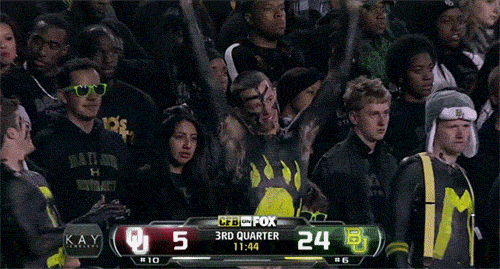
The current College Football Playoff system is going to last 12 years. We’ve already completed 3 of them. It’s pretty easy to project what happens next. The cracks will start showing. But there is a solution. Hopefully that solution isn’t laughed off like the Blockbuster CEO when he was offered to buy Netflix for $50 million.
The Solution
There are 130 teams that compete in NCAA I Football (Football Bowl Subdivision). These teams are allowed to play 12 games in the regular season, and even 13 if they travel to Hawai’i. There are 40 bowl games, which means over 60% of these FBS teams make the post season. There are over 850 college football games in a single season. The majority of these games don’t go to determining a champion. Why?
Make every game matter. Put a tangible significance on every single game. Make every bowl game matter, even the non-playoff ones. Make them matter even to teams that aren’t playing in them. Reward teams for scheduling good opponents and beating them. Punish them for scheduling bad teams and losing to them. Reward teams for building towards success. Save the Bowl system. Increase the number of relevant G5 games without distorting the current balance of power. How do you do that?
The System
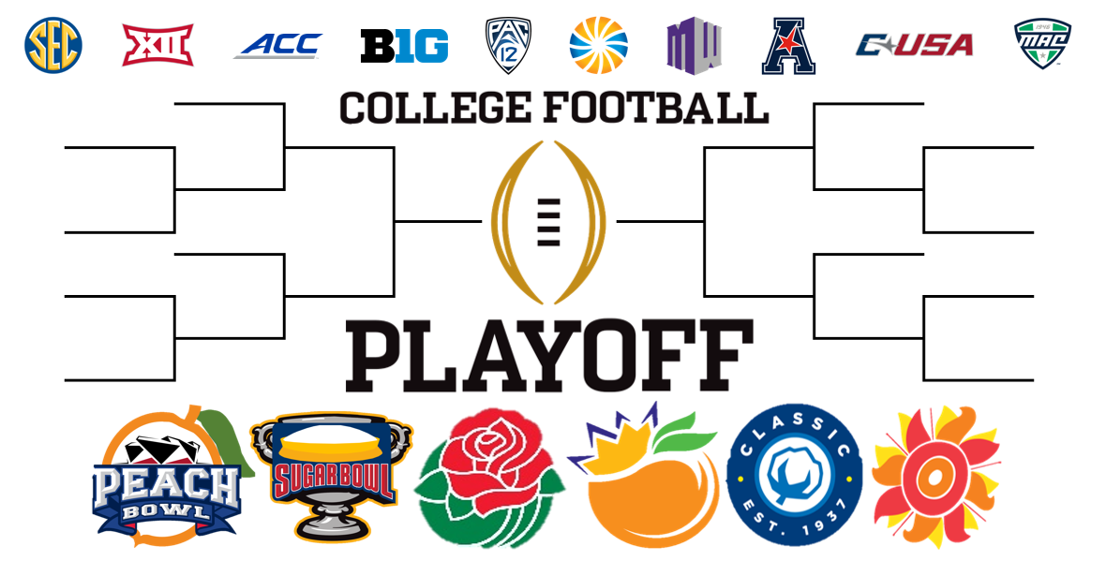

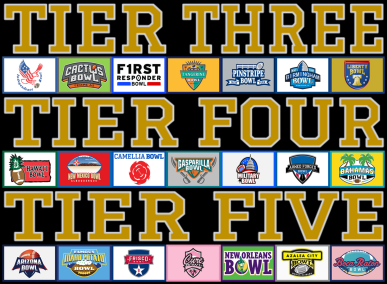
1. Much like with the BCS, each team will be given a rank, using a weighted average of human and computer polls.
2. Based on each teams out of conference performance at the end of the season, a value will be given for every game played against each individual opponent. For an idea of what that a formula might look like, go here.
3. Each individual team score will then be averaged to form a conference score. To see how your favorite conference has fared historically with this ranking system, go here.
4. This conference score and corresponding ranking will then be used for determining byes in the playoff bracket, and slotting in to the different bowl tiers in the following post season.
5. 12 teams will be selected for the playoff. The five P5 Conference Champions, 5 at large P5 teams(and P5 caliber Independents such as Notre Dame and BYU), the highest ranked G5 Conference Champion, and the highest ranked at large G5 team.
The Playoff Bracket

Group 1
The top 4 seeds go to the overall conference Champs from the best two conferences and the next remaining highest ranked members. Conference Champ or otherwise, seeded in order of their final standings. This means that the top two overall teams, regardless of auto bids, will always receive the top two seeds. They will also be seeded a favorable match-up, at most playing the 9th or 10th seed. Their journey to the current final four will be assisted, but it will be deserving.
Group 2
Seeds 5-8 are the next two champions from the next two highest ranked conferences, and the next two at large bids. If one of the next two champions was already selected, then the highest ranked teams remaining will be in their place.
Group 3
The remaining schools are seeded in to the final slots.
Results
Selection Process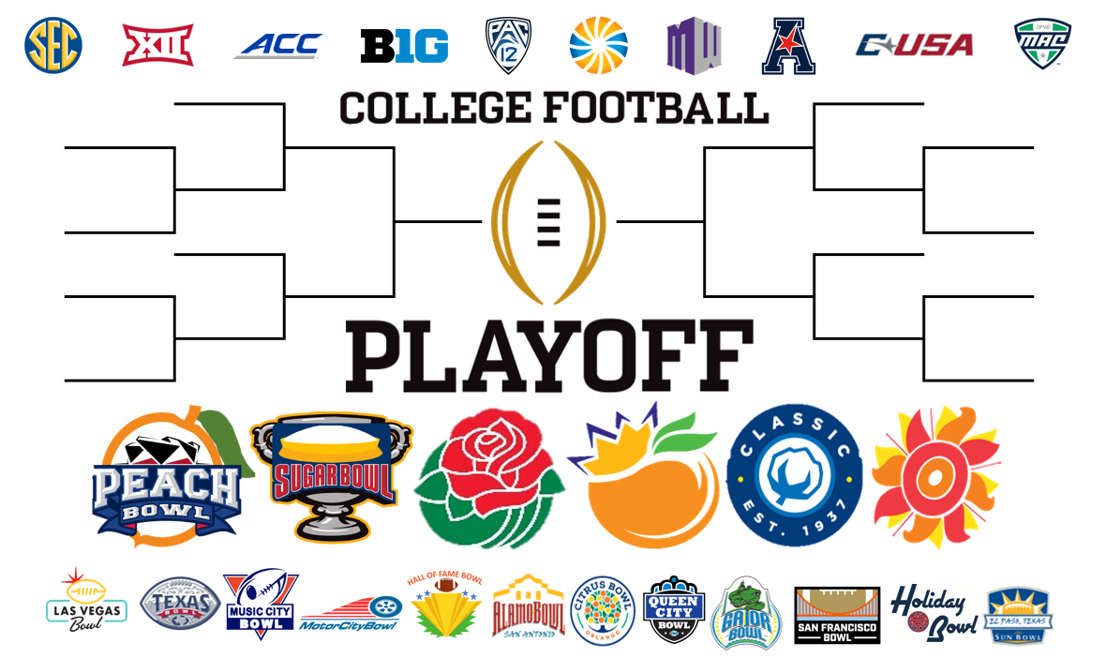
The last two rounds would be the current NY6 Bowls. The first round will be a rotating between 12 locations. The 8 locations not part of the current playoff could then be used as a “next best” tier for bowl coefficients that are higher priority that also includes some auto-bids for “next best” G5 conference champs and top 25 teams.

The Other Bowl Games
The rest of the bowl match-ups could work in a tier system to create a better reward system for the remaining bowl teams. In turn this will show tangible progress for individual programs. Steve Spurrier once said, “You can’t spell Citrus without UT”. We need to return to those days. A nameless, faceless, constantly changing sponsored bowl with varying tie-ins and selection order means nothing.
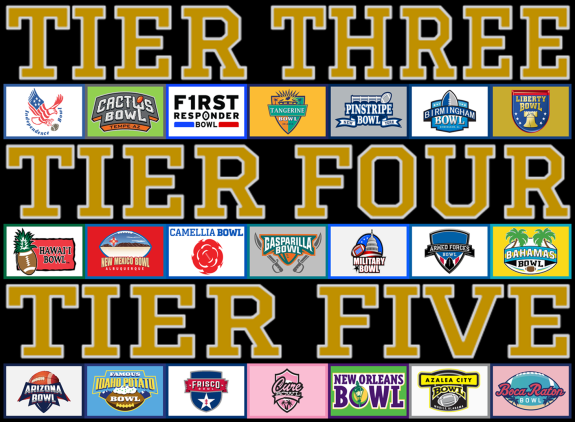
It is not only inventory for the post season, but it’s a measured way for the fans to see the growth of their program.
To see what this system might have looked like in 2017, go here.
Myth Busting
Myth 1: Going beyond 4 teams, or even 8 teams will reward teams that don’t deserve to be crowned National Champions.
Reality: Nick Saban has won 6 National Championships. He has done that twice without winning his conference, and not even winning his division. Why? Because schedules are unbalanced. In highly competitive divisions such as the SEC West without a large enough sample size, a schedule will never do a perfect job of crowning both the best or even the most deserving team. Unless every team within a division only play each other, home and away, or once on a neutral field, this will always be the case. The smaller the discrepancy away from an ideal round robin, the better it will do, but it will always be there.
This concept isn’t lost on the world of college football. It’s why the National Champion used to be crowned with the help of voting. It’s why Conference Titles used to be shared, not with a desire for selfish handouts, but with practicality and reason. It’s why a 2-loss LSU was named National Champions during the BCS era when it was only the top two teams in the “playoff”.
Myth 2: The current format is working because it’s just 1 vs 2 most of the time. The better teams are usually winning. Higher seeds should win most of the time.
In five years of the Playoff, the 10 semi-final games have only had three upsets. so in one sense the “better teams are winning” seems true. However, of the 5 Finals, the lower seeded team has always won. Of the 15 total games, the seeded favorites are 7-8.
What explains this? Is this poor seeding? Proper seeding? Somewhere in the middle?
On one hand, earlier rounds should have less upsets and parity should increase in the final. This would suggest that the higher seeds are correctly ranked.
On the other hand, if the number one overall seed keeps losing, then the seeding is rewarding undeserving teams. Does that mean whatever methodology determines the number 2 seed, which has won three times, should actually be the one seed and get the easier opponent the first round?
Or does this mean that the tournament simply does a job of determining which are the two best teams, not necessarily what order they are in? If so, what does it matter? And as long as the final is on a neutral field, and the three seed and the four seed are generally equal as well, regardless of where they are seeded, what does it matter?
The acknowledgement of relative parity, which these questions are getting at, isn’t foreign to tournaments. The NCAA Men’s Basketball Tournament creates 4 seeding groups. There are four of each seed from 1-16. If the College Football Playoff did this, then the idea that the “number one seed” has never won, wouldn’t be true. Instead, “a” one seed would only have been upset in the final once, but still three times in the first round. Instead of the seeded favorite being under .500, the seeded favorite would be 7-4, as equal seeded match-ups happened the last 4 finals.
But what if the teams seeded 5th was better than the teams seeded 3-4. If seeding between 1-2 could be wrong, why not 4-7? And if the 5th ranked team was let in instead of the 4th, would the same chalk be expected? Would it be better? Or worse? If there are tiers, are the tiers always with two teams? Why or why not? Does the system break down if that’s not the case? More importantly, what happens if that expands.
After all, Alabama and Clemson were both double digit favorites against OU and Notre Dame respectively. They both won by double digits. Would saying that Alabama and Clemson were each one seeds and Oklahoma and Notre Dame were two seeds be more accurate? What about the year before? Georgia went to OT with Oklahoma and Alabama, and Clemson was dominated by Alabama. Is that a tier of 3? If so, how does this progress when the expansion to 8 happens? Does it change it at all? Of course.
The point is that “higher seeding” holding somehow being self evident of a working system will always be flawed. The less granular the seeding, the less important it is,
Tournaments, if designed properly, can strike the appropriate balance between representing both the best teams and the most deserving teams. Higher seeds, and even byes, are a function of rewarding teams for performance prior to the tournament. This also has the added benefit of ensuring that lower seeded teams will have to face challenging opponents to compensate for their performance prior to the tournament.
Myth 3: A committee should just select the 8 or 12 best teams regardless of everything else.
This is the common proposal. Just do what the 4 team playoff does, but expand it. A common caveat to this, is that each of the Power 5 Champs get an automatic bid, and only one Group of 5 Champ gets an automatic bid, and the committee selects the rest.
In reality, the brackets might not look that different than this proposal, which is a good thing.
To begin with, the teams selected would be almost identical, except for the “at-large G5 team”. The seeding order, while potentially radically different due to slotting conference bids, generally won’t be. In 2017, the ACC and the SEC being the top two rated conferences, had Clemson in Georgia in the top group anyway. While the Big 12 wasn’t, Oklahoma would still receive the number 2 overall bid and an easy path vs Memphis or Miami (FL) to the final four.
Yet, by just saying, “it’s close enough” is almost missing the point. Understanding the design of the playoff and how it will develop competition within the sport is actually more important. The current College Football Playoff Committee doesn’t create a top 25 after Bowl Season. If they did, it would be significantly different than the one used for Bowl Selection. Why? Because no system is perfect, and no result will vindicate any system time and time again. However, a system that knows it’s imperfect and expects variance can handle upsets as they weren’t really upsets at all.
